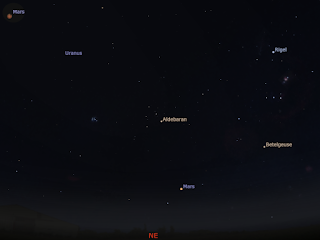Tuesday, November 15, 2022
Thursday November 17 to Thursday November 24
The New Moon is Thursday, November 24. Jupiter is easy to see as brightest object in the evening sky aside from the Moon. Mars is now rising before midnight, but is still best to see in the morning. Mars forms a triangle with the bright stars Elnath and Zeta Taurii, the tips of the horns of the Bull, but is now moving up the horns back towards red Aldebaran. Mercury and Venus enter the evening twilight but are nearly impossible to see.
The New Moon is Thursday, November 24. The Moon is at perigee, when it is closest to the Earth, on the 26th.
Evening sky on Thursday, November 24 as seen from Adelaide at 20:36 ACDST, (30 minutes after sunset, click to embiggen). Venus and Mercury are low above the horizon deep in the twilight. You will need a low, unobstructed horizon like the ocean to see them (and possibly binoculars as well).
Similar views will be seen from the rest of Australia at the equivalent
local time (30 minutes after sunset).
Mars is rising around 21:00 am non-daylight saving time (22:00 daylight saving time) but is best seen in the morning. The inset is the telescopic view at this time.
Similar views will be seen from the rest of Australia at the equivalent local time.
Saturn forms a line with iota, delta and gamma Capricornii with Jupiter to the north.
The insets are the telescopic views of Saturn and Jupiter at the same magnification at this time.
Similar views will be seen from the rest of Australia at the equivalent
local time (90 minutes after sunset).
Scorpius is sinking in the western horizon with the teapot of Sagittarius above. The low altitude makes the clusters of Sagittarius hard to make out.
The Scorpions foe, Orion the Hunter, is rising in the east.
Between the bright star Canopus and the Southern Cross are another wealth of binocular objects to discover.
Elsewhere in Australia will see a similar view at the equivalent time (90 minutes after sunset).
Mercury climbs out of the twilight.
Venus climbs out of the twilight.
Mars forms a triangle the bright stars Elnath and Zeta Taurii, the tips of the horns of the Bull, but is now moving up the horns back towards red Aldebaran.
Jupiter climbs higher in the late evening sky was at opposition, when it was biggest and brightest as seen from Earth, on the 27th of September. Jupiter is visible all night.
Saturn forms a line with iota, delta and gamma Capricornii. Saturn was at opposition, when it was biggest and brightest as seen from Earth, on the 15th of August.
Star Map via Virtual sky. Use your mouse to scroll around and press 8 when your pointer is in the map to set to the current time.
Cloud cover predictions can be found at SkippySky.
Here is the near-real time satellite view of the clouds (day and night) http://satview.bom.gov.au/
Labels: weekly sky








 Click to read about or order
Click to read about or order Click to read about or order
Click to read about or order Click to read about or order
Click to read about or order Click to read about or order
Click to read about or order




